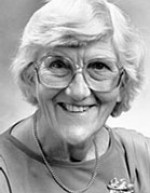
Contents
View Professor Nancy Millis' photo gallery
You can order the DVD from the Academy for $15 (including GST and postage)
Professor Nancy Millis was interviewed in 2001 for the Interviews with Australian scientists series. By viewing the interviews in this series, or reading the transcripts and extracts, your students can begin to appreciate Australia's contribution to the growth of scientific knowledge.
The following summary of Millis's career sets the context for the extract chosen for these teachers notes. The extract is from a section of the interview in which she talks about her interest in the ecological aspects of water quality. Use the focus questions that accompany the extract to promote discussion among your students.
Nancy Millis was born in 1922 in Melbourne, Victoria. She received a Bachelor of Agricultural Science in 1945, a Master of Agricultural Science in 1948 and a Doctorate in Science (Hon) in 1993, all from the University of Melbourne. She was awarded a Boots Research Scholarship in the UK and used it to study at the University of Bristol where she received a PhD in 1952. Her doctoral research was on microbial growth and fermentation in cider that started her lifelong interest in anything that ferments.
From 1952-1988 Millis was at the Department of Microbiology at the University of Melbourne. She became senior demonstrator in 1952 and lecturer in 1954. She was awarded a personal chair in 1982 and held it until her retirement. She was awarded emeritus professor status in 1987 in the Department of Microbiology and Immunology. In her time at the university, she set up the applied microbiology course and worked to link universities and industry.
Millis was involved in the setting up of the Recombinant DNA Monitoring Committee in 1980. This committee was replaced in 1987 by the Genetic Manipulation Advisory Committee (GMAC), which she chaired until June 2001 when GMAC was replaced by the Gene Technology Technical Advisory Committee.
In 1977 she was awarded an MBE and elected to Fellowship of the Australian Academy of Technological Sciences. In 1987 she became an Honorary Life Member of the Australian Society for Microbiology and in 1990 she became a Companion in the Order of Australia.
In 1992 Millis became Chancellor of La Trobe University, Melbourne. She chairs the Cooperative Research Centre for Water Quality and Treatment and is on the board of the CRC for Freshwater Ecology.
Why Port Phillip isn’t green soup: an ecological investigation
You have talked about reducing pesticide use. You have also done a lot of work on the environmental aspects of water quality, haven’t you?
Yes. I’ve been interested in water, and its effects on the environment which receives it, for a long time. For quite a number of years we studied the cycling of nutrients in Port Phillip Bay and Westernport Bay. In particular, the sewage treatment plant at Werribee discharges treated effluent into Port Phillip Bay. The nitrogen it contains is often in the form of nitrate, or is, indeed, denitrified in summer, but certainly in winter a fair amount of ammonia goes into the bay. The question has been what happens to the nitrogen when it is released.
I have always felt that denitrification is a very important process – which takes me right back to my Masters year – in the bay’s ecology. And CSIRO has recently completed an absolutely marvellous, five-year intensive study of the health of the bay, which has nailed down the question in some extremely nice experiments.
In the middle of the bay there is a big layer, about 20 centimetres, of soft, sludgy material which contains very large numbers of burrowing worms and shrimps. When nitrogen comes into the water column it tends to go towards the bottom of the bay, carried there both in solution and as particles of algae and other pieces of organic material. There it is broken down. The ammonia in that water layer, because there’s oxygen about, is oxidised to nitrate. Then all these little burrowing insects that live in the bottom suck the water – and of course the nitrate – down into their burrows. In the anaerobic environment of the sediment outside the burrows, the nitrate is denitrified by bacteria, and now the nitrogen is in the form of gas and goes out of the system.
That big cycle of nitrogen removal, whereby combined nitrogen goes in, gets oxidised from ammonia to nitrate, and then is reduced to nitrogen gas which is released, is an enormously important reason why Port Phillip Bay isn’t green soup. And so it’s very important that the ecosystem in the bottom of the bay is not disturbed.
There is always the problem, too, that if you just go on loading up the system it will collapse. Its capacity to handle the load will be exceeded. So the amount of nitrogen being released into the bay must be carefully controlled and limited. Indeed, the Environment Protection Authority has a careful eye on this.
An edited transcript of the full interview can be found at http://www.science.org.au/node/327223.
Focus questions
Select activities that are most appropriate for your lesson plan or add your own. You can also encourage students to identify key issues in the preceding extract and devise their own questions or topics for discussion.
anaerobic environment
cycling of nutrients
denitrification
ecosystem
nitrogen
oxidation
reduction
water quality
© 2025 Australian Academy of Science